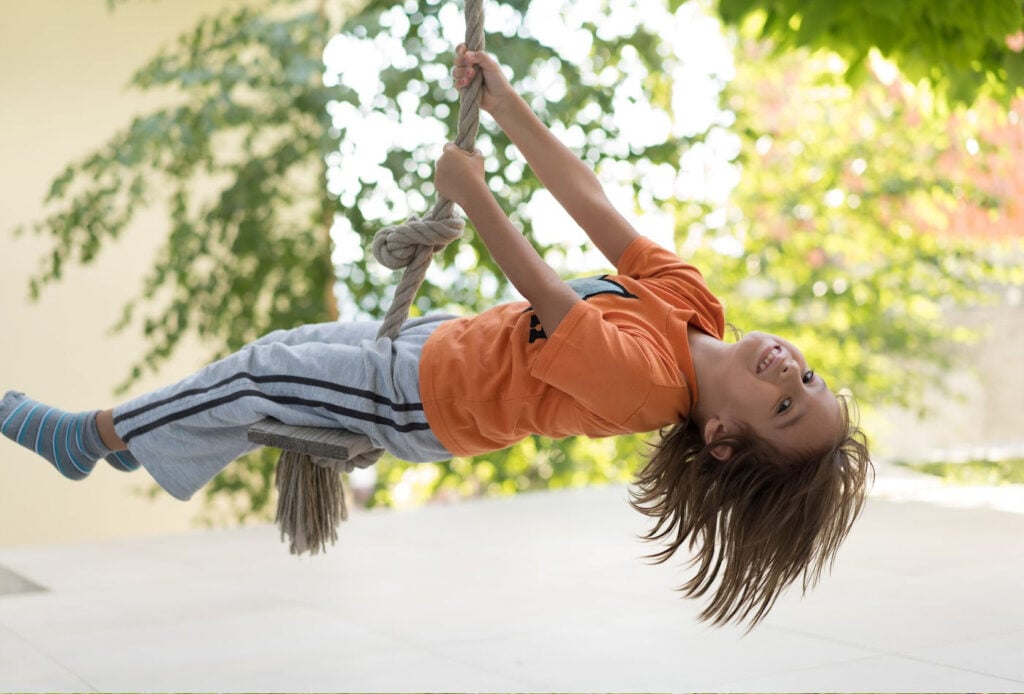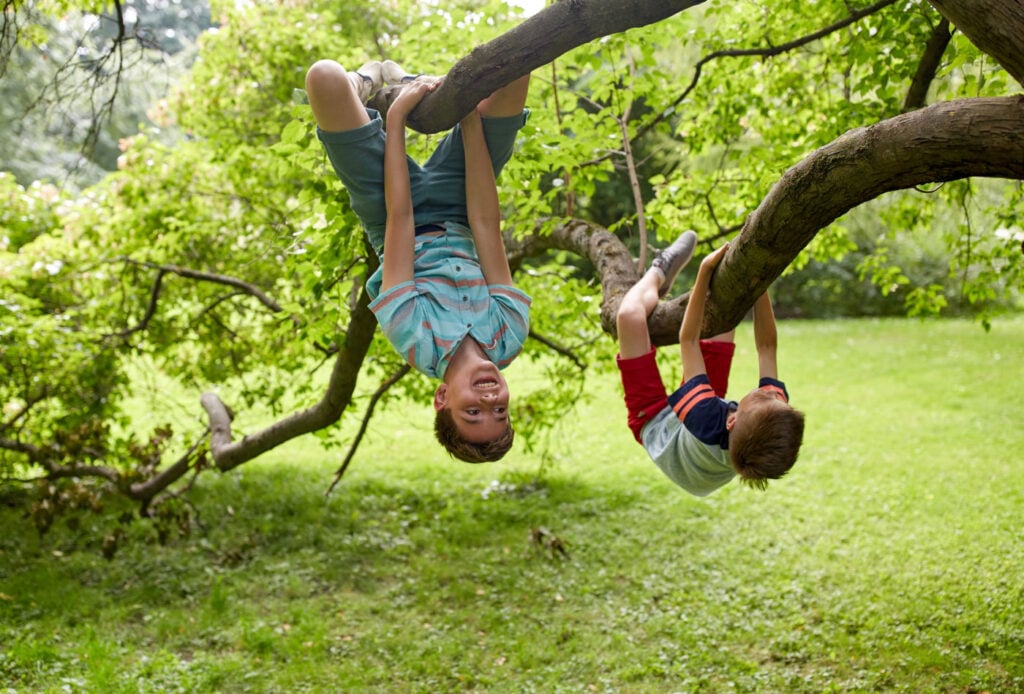How Outdoor Play Stimulates a Child’s Vestibular System
The vestibular system is one of your child’s most important sensory systems. It plays a major role in the overall development of a growing child. It specifically impacts the brain, balance, and gross motor movement.
But because kids today are less active, many suffer from an underdeveloped vestibular sense. Here’s how outdoor play naturally strengthens this crucial system.

Table of contents
When pediatric occupational therapist Angela Hanscom did a small pilot study of American fifth graders, she was stunned to learn that less than ten percent had the core strength and balance skills of the average child 30 years prior.
When they were asked to complete simple balance tasks, like spinning in circles, the children fell to the ground, struggled to move at a regular pace, and had to use their arms for guidance. Hanscom was alarmed.
The tests told her that the vast majority of the children had an underdeveloped vestibular sense.
The culprit?
Likely the loss of free outdoor play (also called Nature Deficit Disorder) and physical activity that has happened in just a generation.
What is the Vestibular System?
If you’ve never heard of the vestibular sense, or equilibrioception, you’re not alone. Most of us only learned about the five basic senses – sight, hearing, touch, smell, and taste – in elementary school. But the vestibular sense is crucial to proper development.
Also known as the balance or gravity sense, the vestibular sense communicates where our bodies are positioned in relation to our surroundings. It tells us if we are moving or still, at what speed we are moving and in which direction we are going.
The vestibular system is centered in our inner ear, where fluid is moving back and forth along with our head and body movements. The fluid in turn stimulates little hairs that send information about our body’s movements and position to integrative centers in the brain.
The Importance of the Vestibular System
Although we’re not aware of it, the vestibular system helps us move smoothly, keep our heads and bodies upright and maintain a sense of balance. It is interconnected with our hearing and vision and stabilizes our eye movements when we are walking.
Children with a well-developed vestibular sense generally come across as having good coordination, balance, and body awareness. Conversely, children with an underdeveloped vestibular sense not only run the risk of tripping and falling more than others, they may also fidget more in the classroom, since the understimulation of the vestibular system makes them crave movement.
They may also have trouble with attention and feel frustrated and angry, Hanscom writes in her book Balanced and Barefoot. Other experts have found that vestibular dysfunction can affect a child’s ability to problem solve, read, do math, navigate, memorize and multitask.
How to Strengthen and Stimulate a Child’s Vestibular System
Here’s the good news: Children are wired to seek out the sensory stimulation that they need and can develop a strong vestibular system just by engaging in everyday play and movement.
Simply walking and running strengthens the vestibular sense and activities that go against gravity – spinning, tumbling, climbing, rolling, jumping, swinging, hanging upside down – are especially beneficial.
The outdoors is the perfect place for children to play and challenge their bodies in these ways, as the opportunities for varied vestibular stimulation are virtually endless outside the confines of four walls.
Types of Outdoor Play That Enhance the Vestibular Sense
To be perfectly clear, play is not something that can be prescribed to a child or forced by adults. It’s always freely chosen and directed by the child, otherwise it’s not play but an activity. It’s also important to recognize that children play because it’s fun, not to get a leg up on their sensory development.
But as children today tend to live more indoor and sedentary lives than ever before, caregivers are key when it comes to providing opportunities for outdoor play.
By giving your child the time and space to challenge themselves in both natural outdoor environments, such as forests, and planned environments, like a playground or backyard, you are giving them the best chances of a normal vestibular development.

Types of outdoor play that strengthen your child’s vestibular system:
- Swinging from the monkey bars
- Rolling or somersaulting down a hill
- Playing “the ground is lava” using rocks, roots, stumps etc
- Hanging upside down on on a pull-up bar
- Spinning on a merry-go-round
- Tumbling and doing cartwheels
- Balancing on a log or balance beam
- Doing a handstand
- Climbing a tree, ladder or climbing wall
- Bouncing on a trampoline
- Spinning in circles on the ground or on a swing
- Rocking in a hammock
- Playing hopscotch
- Going down a slide (or climbing up, as long as no other child is coming down at the same time!)
- Doing an obstacle course
- Jumping in puddles
- Hanging by the hands from a tree branch
- Swimming
- Running, skipping or galloping
- Riding a tricycle or bike
What If a Child Has Difficulties With Vestibular Processing?
Children who have difficulties with their vestibular system tend to fall into one of two categories: they are either over-responsive or under-responsive to movement. Having said that, some children may show symptoms of both over-responsiveness and under-responsiveness.
Over-responsiveness
A child who is overresponsive (or hypersensitive) to movement may:
- avoid playground equipment
- move slowly and cautiously
- be more sedentary
- cling to an adult
- show a fear of heights, using stairs or falling
- be afraid of any activities that require balance
- appear clumsy and losing balance easily
- become dizzy or motion sick frequently
- have a hard time navigating in the dark and/or on uneven surfaces
- have delayed motor development
Under-responsiveness
Conversely, a child who is underresponsive (or hyposensitive) to movement may:
- move constantly
- crave intense movements, like spinning and swinging fast and high
- enjoy adrenaline-inducing activities like rollercoasters
- jump, bumping and crashing into things
- fidget and having trouble staying focused
- have trouble staying out of others’ personal space
Supporting Your Child’s Vestibular Development
According to Kristin Palen, a nature-based occupational therapist in Outer Banks, North Carolina, signs of sensitivity to vestibular input can be subtle and easily missed. She advises parents to be observant of how their child moves and how they respond to vestibular input.
On the playground, is the child afraid of using the climbing equipment or are they typically prone to climbing too high? Or maybe they are fine going up on the equipment but are afraid to come down? Either way, it could be a sign of an underdeveloped vestibular system.
As tempting as it may be, telling an overresponsive child things like, “Come on, you can do it!”, or “It’s not too high!” or “It’s not scary!” can be counter-productive, as it may push them beyond their limits and make them avoid vestibular activities even more, Palen advised. “Instead, offer your child as much support as needed initially, validate their feelings, and begin where they are comfortable.”
To help an underresponsive child with regulation, you can offer calming and relaxing activities, for example tight hugs, crawling or weight-bearing activities, before, during and after vestibular activities. If your child’s sensitivity to vestibular input is affecting their everyday life negatively, an occupational therapist can help.
Enabling Normal Vestibular Development
There are many reasons why children today are not getting the vestibular stimulation they need and crave, but one thing is for sure – an indoor, sedentary lifestyle is not helping.
The World Health Organization recommends that children from one to five years old get at least three hours of physical activity every day and following that recommendation will go a long way in helping your child develop good balance, coordination and body awareness. And the more of that time that is spent engaging in good ol’ free outdoor play, the better.
Find more ideas on physical activity and free play outdoors here:
The Benefits of Open Air Living
Playing in the Rain: Getting kids outside in any weather
